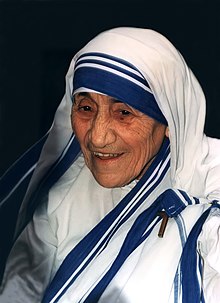
Back Moeder Teresa Afrikaans Mutter Teresa ALS እምዬ ቴሬሳ Amharic Santa Teresa de Calcuta AN الأم تريزا Arabic الام تيريزا ARZ মাদাৰ টেৰেছা Assamese Teresa de Calcuta AST Tayka Teresa Aymara Tereza Ana Azerbaijani
Teresa of Calcutta | |
|---|---|
 Mother Teresa in 1995 | |
| Virgin | |
| Born | Anjezë Gonxhe Bojaxhiu 26 August 1910 Üsküp, Kosovo Vilayet, Ottoman Empire |
| Died | 5 September 1997 (aged 87) Calcutta, West Bengal, India |
| Venerated in | Catholic Church |
| Beatified | 19 October 2003, Saint Peter's Square, Vatican City by Pope John Paul II |
| Canonized | 4 September 2016, Saint Peter's Square, Vatican City by Pope Francis |
| Major shrine | Mother House of the Missionaries of Charity, Calcutta, West Bengal, India |
| Feast | 5 September[1] |
| Patronage | |
| Title | Superior general |
| Personal | |
| Religion | Catholicism |
| Nationality |
|
| Denomination | Catholic |
| Signature | |
| Organization | |
| Institute |
|
| Senior posting | |
| Period in office | 1950–1997 |
| Successor | Sr. Nirmala Joshi, MC |
Mary Teresa Bojaxhiu MC (born Anjezë Gonxhe Bojaxhiu, Albanian: [aˈɲɛzə ˈɡɔndʒɛ bɔjaˈdʒi.u]; 26 August 1910 – 5 September 1997), better known as Mother Teresa,[a] was an Albanian-Indian Catholic nun and the founder of the Missionaries of Charity. Born in Skopje, then part of the Ottoman Empire,[b] at the age of 18 she moved to Ireland and later to India, where she lived most of her life. On 4 September 2016, she was canonised by the Catholic Church as Saint Teresa of Calcutta. The anniversary of her death, 5 September, is her feast day.
Mother Teresa founded Missionaries of Charity, a religious congregation, which grew to have over 4,500 nuns across 133 countries as of 2012[update].[6] The congregation manages homes for people who are dying of HIV/AIDS, leprosy, and tuberculosis. The congregation also runs soup kitchens, dispensaries, mobile clinics, children's and family counselling programmes, as well as orphanages and schools. Members take vows of chastity, poverty, and obedience and also profess a fourth vow: to give "wholehearted free service to the poorest of the poor."[7]
Mother Teresa received several honours, including the 1962 Ramon Magsaysay Peace Prize and the 1979 Nobel Peace Prize. A controversial figure during her life and after her death, Mother Teresa was admired by many for her charitable work, but was criticised for her views on abortion and contraception, as well as the poor conditions in her houses for the dying. Her authorised biography, written by Navin Chawla, was published in 1992, and she has been the subject of many other works. On 6 September 2017, Mother Teresa and Saint Francis Xavier were named co-patrons of the Roman Catholic Archdiocese of Calcutta.
- ^ "St. Teresa of Kolkata". Catholic News Agency. Archived from the original on 8 October 2018. Retrieved 6 September 2023.
- ^ Banerjee, Manik (6 September 2017). "Vatican declares Mother Teresa a patron saint of Calcutta". Associated Press. Archived from the original on 6 September 2017. Retrieved 6 September 2017.
- ^ "Mother Teresa to be named co-patron of Calcutta Archdiocese on first canonization anniversary". First Post. Indo-Asian News Service. 4 September 2017. Archived from the original on 26 April 2020. Retrieved 5 September 2017.
- ^ Cite error: The named reference
Cannon2013was invoked but never defined (see the help page). - ^ "Kur Nënë Tereza vinte në Tiranë/2" [When Mother Teresa came to Tirana/2]. Shqiptari i Italisë (in Albanian). 2 December 2010. Archived from the original on 18 September 2016. Retrieved 4 September 2016.
- ^ Poplin, Mary (2011). Finding Calcutta: What Mother Teresa Taught Me About Meaningful Work and Service. InterVarsity Press. p. 112. ISBN 978-0-8308-6848-3. Archived from the original on 1 February 2022. Retrieved 3 October 2020.
- ^ Muggeridge (1971), chapter 3, "Mother Teresa Speaks", pp. 105, 113
Cite error: There are <ref group=lower-alpha> tags or {{efn}} templates on this page, but the references will not show without a {{reflist|group=lower-alpha}} template or {{notelist}} template (see the help page).
© MMXXIII Rich X Search. We shall prevail. All rights reserved. Rich X Search